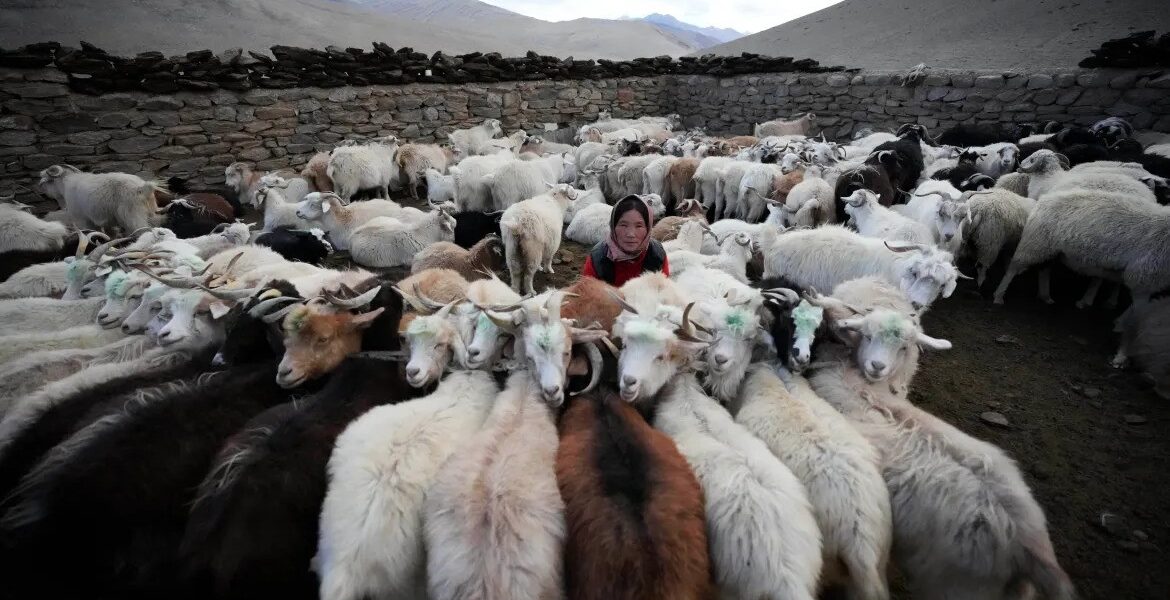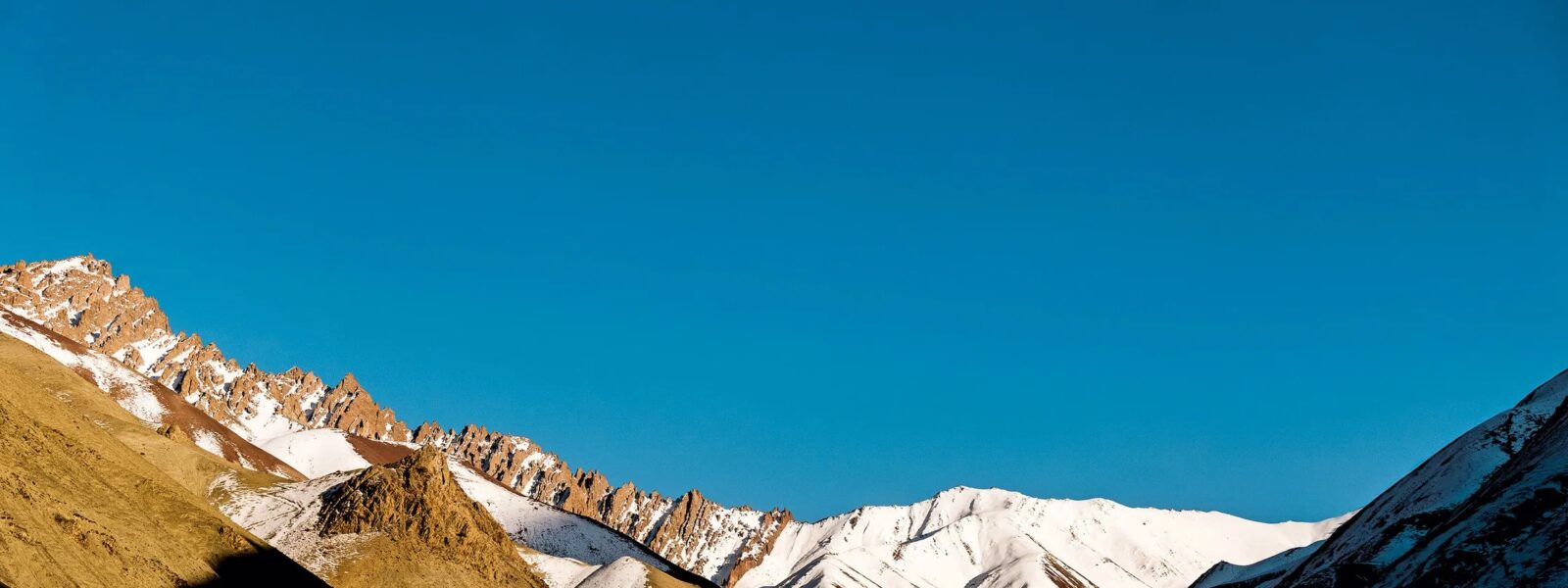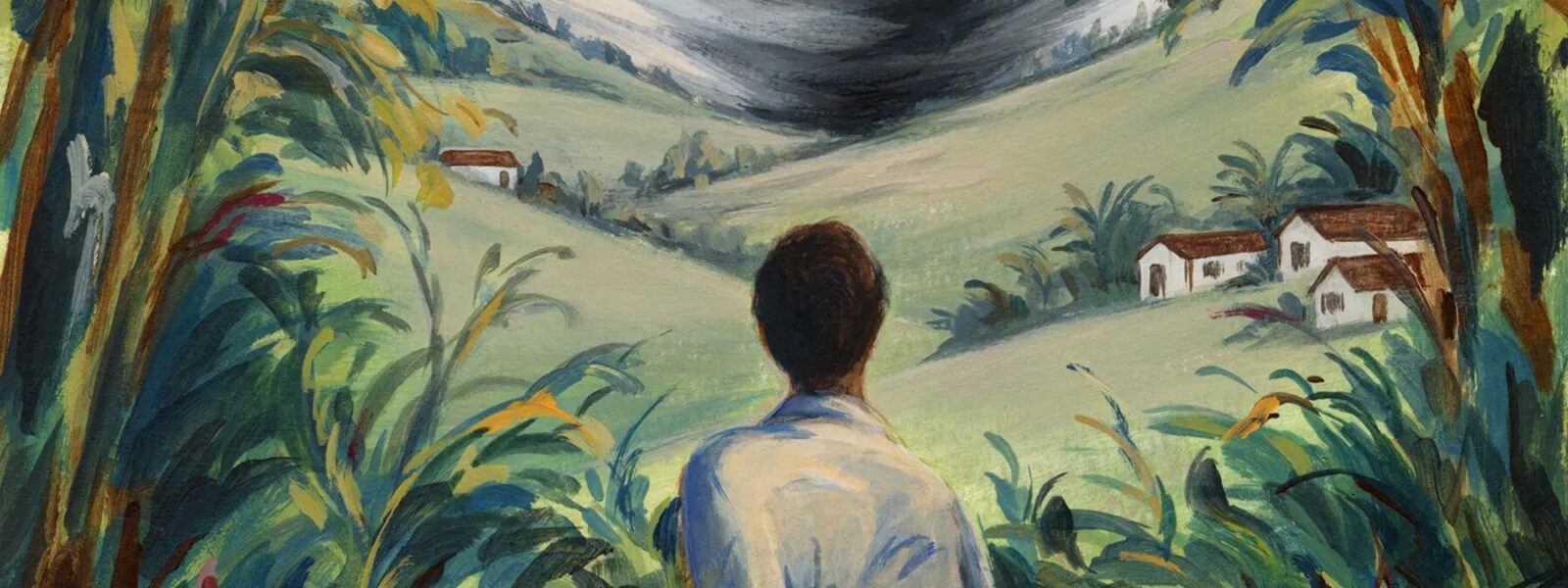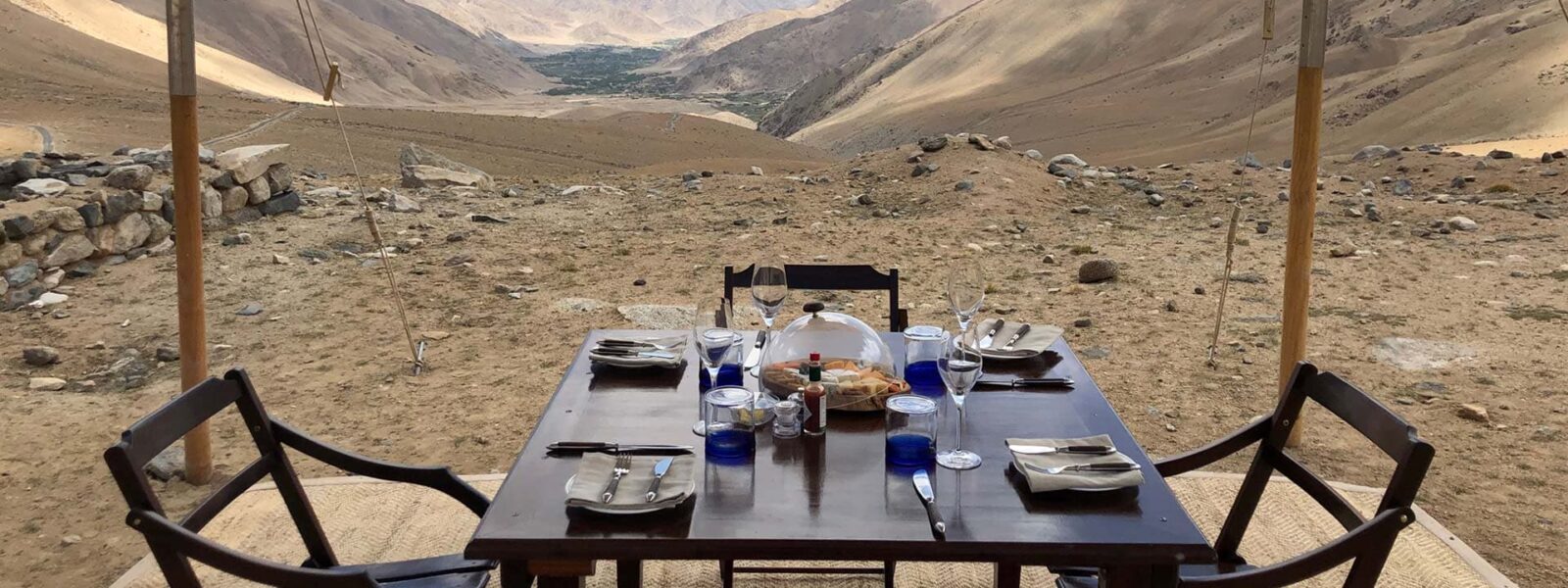Ladakh, a rugged paradise cradled by the Himalayas, beckons adventurers with its windswept trails and ancient secrets. Far beyond its bustling monasteries and vibrant markets lies a realm of forgotten kingdoms—abandoned mountain settlements whispering tales of a bygone era. Trekking to these desolate ruins offers a journey through time, where every step unveils the mystique of a landscape shaped by nature and history. This guide dives into the best routes, practical tips, and the haunting beauty of Ladakh’s lost kingdoms, making it your ultimate companion for an unforgettable adventure.
The Enchantment of Trekking to Ladakh’s Lost Kingdoms
Why Abandoned Kingdoms in Ladakh Beckon Trekkers
Ladakh’s abandoned mountain kingdoms are more than just relics; they’re a siren call to trekkers seeking solitude and discovery. Imagine standing amidst crumbling stone walls, the wind howling through desolate valleys, carrying echoes of a forgotten past. These ancient settlements, once thriving hubs of trade and culture along the Silk Route, now stand as silent sentinels in the Himalayan wilderness. The allure lies in their isolation—far from crowded tourist trails, they offer a raw, unfiltered connection to history.
For adventure seekers, trekking to these lost kingdoms combines physical challenge with emotional resonance. The rugged terrain tests your endurance, while the sight of weathered stupas and ruined forts stirs a sense of wonder. Keywords like “Ladakh treks to abandoned mountain kingdoms” and “ancient Ladakh kingdoms” naturally fit here, as they capture the essence of this unique experience. Unlike popular peaks, these trails lead to hidden gems—villages like Yurutse or monasteries abandoned to time, where the silence is as profound as the scenery.
The appeal isn’t just historical; it’s visceral. The high-altitude air, crisp and thin, heightens every sensation as you traverse untamed landscapes. Trekkers often describe a feeling of stepping into a lost world, where every footprint feels like a claim to something sacred. This isn’t about conquering a summit but about immersing yourself in a narrative etched into the earth. Whether you’re a solo wanderer or a group explorer, the promise of uncovering Ladakh’s forgotten past makes these treks irresistible.
Beyond the physical journey, there’s a meditative quality to these expeditions. The desolate beauty of Ladakh’s ruins—set against stark cliffs and endless skies—offers a rare chance to disconnect from modernity. For those searching “trekking to abandoned mountain villages in Ladakh,” this is the answer: a pilgrimage to places where time stands still, blending adventure with introspection.
The Unique Appeal of Ladakh’s Rugged Highlands
Ladakh’s rugged highlands are a trekkers’ playground, distinct from any other Himalayan region. The stark, moon-like terrain—dotted with jagged peaks and barren plateaus—creates an otherworldly backdrop for your journey. Unlike lush alpine trails, Ladakh’s untamed landscapes challenge you with their austerity, making every trek a test of resilience. This uniqueness is why “Ladakh rugged landscapes” and “untamed terrain” resonate so deeply with adventure enthusiasts.
What sets these highlands apart is their blend of natural majesty and cultural remnants. You’ll encounter ancient chortens (stupas) weathered by centuries, prayer flags fluttering in the wind, and the occasional glimpse of a crumbling village perched improbably on a cliff. These elements elevate a simple hike into a cultural odyssey, aligning perfectly with “Ladakh mountain trekking routes.” The trails wind through vast, open expanses where the horizon stretches endlessly, punctuated only by the ruins of lost kingdoms.
The high-altitude environment—often above 3,500 meters—adds a layer of intensity to the experience. The thin air and extreme weather demand preparation, but they also amplify the reward. Standing atop a windswept ridge, gazing at a desolate monastery or abandoned settlement below, you feel the weight of history and the power of solitude. This is trekking for those who crave more than scenic views; it’s a journey into Ladakh’s soul, where every step reveals a new facet of its wild beauty.
For those researching “Ladakh trekking guide,” the highlands offer unparalleled diversity. From arid valleys to rocky passes, the terrain keeps you on your toes, while the cultural echoes—stone carvings, faded murals—tell stories of a once-thriving civilization. It’s this combination of physical challenge and historical intrigue that makes Ladakh’s rugged highlands a must-visit for trekkers worldwide.

Top Trekking Routes to Ladakh’s Forgotten Settlements
Markha Valley Trek: Unveiling Hidden Villages
The Markha Valley Trek is a crown jewel among Ladakh’s trails, renowned for its remote villages and haunting ruins. Spanning roughly 80 kilometers, this route takes you through a tapestry of barren hills, narrow gorges, and isolated hamlets—perfect for those seeking “best treks in Ladakh.” Starting near Leh, the trek winds toward the Markha River, where tiny settlements like Sara and Markha cling to life amidst the wilderness.
What makes this trek special is its access to Ladakh’s forgotten past. Along the way, you’ll stumble upon abandoned structures—crumbling homes and ancient mani walls—that hint at a time when these valleys buzzed with activity. Keywords like “exploring Ladakh ruins” and “trekking Ladakh off the beaten path” fit naturally here, as the trail avoids mainstream tourist hubs. The village of Hankar, with its derelict fortress, stands as a testament to the region’s lost kingdoms, offering trekkers a glimpse into a vanished era.
The landscape itself is a marvel: towering cliffs frame the valley, while the occasional ibex or blue sheep darts across the slopes. The trek’s moderate difficulty—typically 6-8 days—makes it accessible to fit beginners, yet its isolation appeals to seasoned adventurers. You’ll camp under starlit skies, far from civilization, with the silence broken only by the wind—a true “Ladakh treks to abandoned mountain kingdoms” experience.
Practical tips: Acclimatize in Leh first, carry ample water (streams can dry up), and pack layers for temperature swings. The reward is immense—standing in a deserted village, surrounded by rugged peaks, you’ll feel like an explorer unearthing a hidden world. This trek’s blend of natural beauty and historical echoes makes it a top pick for uncovering Ladakh’s forgotten settlements.
Nubra Valley Trek: Pathways to Desolate Monasteries
The Nubra Valley Trek offers a quieter, less-trodden path to Ladakh’s abandoned wonders, with desolate monasteries as its centerpiece. Known for its dramatic dunes and stark beauty, Nubra lies north of Leh, accessible via the high Khardung La pass. This trek, often spanning 5-7 days, weaves through arid valleys and rocky trails, leading to spiritual relics lost to time—perfect for “solo travel Ladakh monasteries” seekers.
One highlight is the ancient Diskit Monastery, still active but surrounded by forgotten outposts that once served as hermitages. Beyond Diskit, the trail reveals smaller, abandoned gompas (monasteries) perched on cliffs, their faded murals and broken altars evoking a sense of mystery. “Lost villages of Ladakh” and “trekking Ladakh’s ancient ruins” fit seamlessly here, as you encounter hamlets like Hunder, where time seems frozen amidst sand and stone.
The trek’s isolation is its charm. Far from crowded routes, you’ll traverse windswept plains and narrow paths, with Bactrian camels roaming in the distance—a nod to Nubra’s Silk Route legacy. The altitude hovers around 3,000-4,000 meters, demanding acclimatization but offering breathtaking vistas of snow-capped peaks. This is a journey for those who crave solitude and history in equal measure.
Logistics matter: Start early to avoid midday heat, and hire a local guide for lesser-known trails to abandoned sites. The payoff is a profound connection to Ladakh’s spiritual past, where every ruined monastery tells a story of resilience against nature’s harsh embrace. For trekkers chasing “Ladakh adventure travel,” Nubra delivers an unforgettable off-grid experience.
Lamayuru to Chilling: A Journey Through History
The Lamayuru to Chilling trek is a historical odyssey through Ladakh’s rugged heart, linking ancient monasteries with forgotten villages. Stretching over 5-6 days, this 50-kilometer route begins at Lamayuru—home to one of Ladakh’s oldest gompas—and ends near Chilling, a riverside hamlet. It’s a trek steeped in “Ladakh trek history,” offering a window into the region’s abandoned mountain kingdoms.
Lamayuru itself sets the tone, its moonscape surroundings dotted with ancient ruins and weathered stupas. As you trek toward Wanla and beyond, you’ll pass deserted settlements like Prinkiti La, where stone walls stand as silent witnesses to a lost way of life. “High-altitude trekking Ladakh” comes alive here, with passes like Konzke La (4,900 meters) testing your mettle amidst jaw-dropping views.
The trail follows the Yapola River, winding through gorges and plateaus where the remnants of Ladakh’s past—forts, prayer wheels, and crumbling homes—blend into the landscape. This isn’t just a physical journey; it’s a passage through time, aligning with “Ladakh treks to abandoned mountain kingdoms.” The solitude of these highlands, coupled with their historical weight, creates an immersive experience unlike any other.
Preparation is key: Expect steep ascents, cold nights, and limited water sources. Yet, the reward is standing amidst a forgotten village, the wind carrying whispers of ancient traders and monks. This trek appeals to history buffs and adventurers alike, offering a perfect blend of challenge and discovery along Ladakh’s timeless trails.
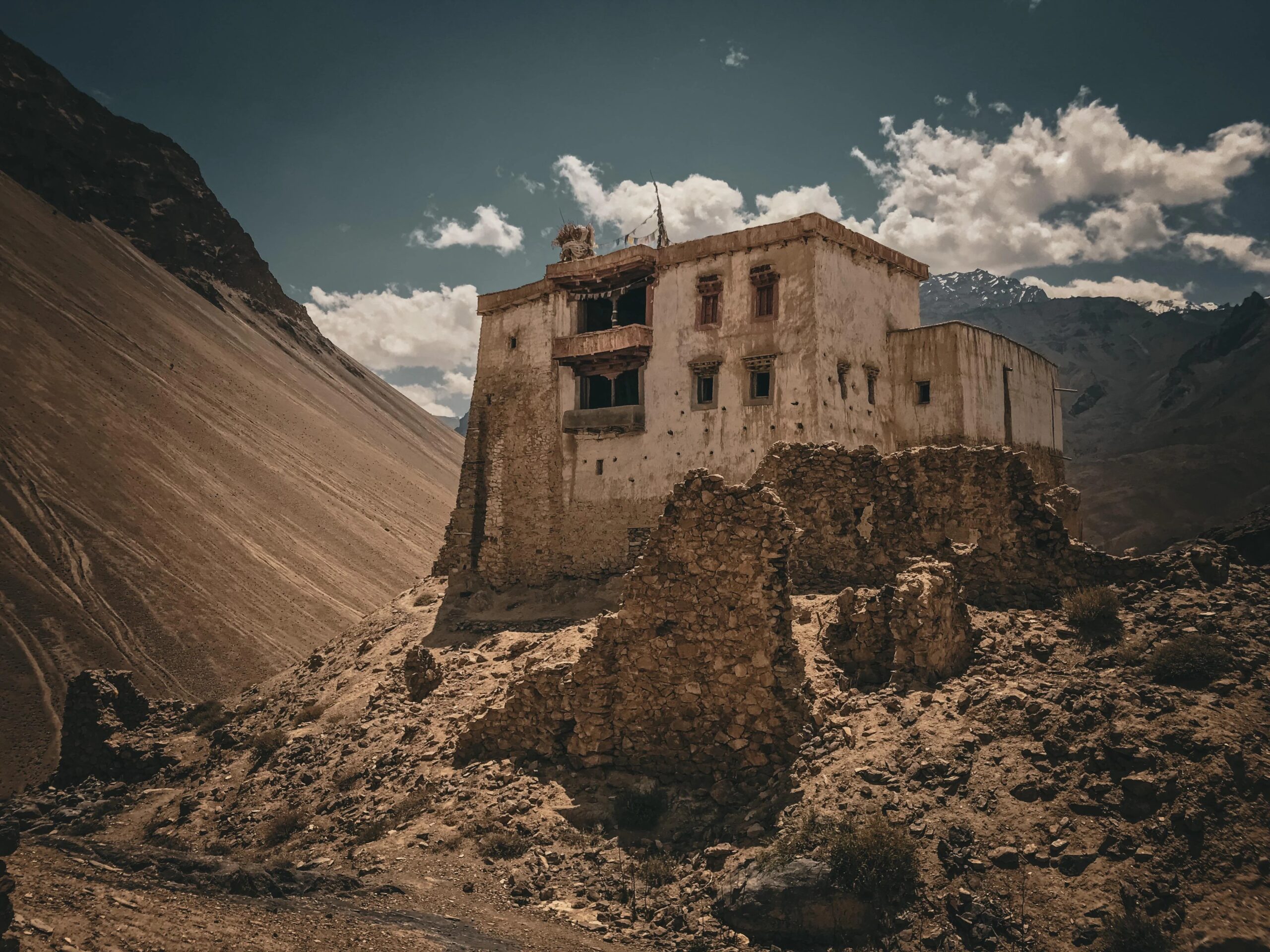
How to Plan Your Trek to Ladakh’s Abandoned Kingdoms
Must-Have Gear for Ladakh Mountain Treks
Trekking to Ladakh’s abandoned mountain kingdoms demands the right gear—your lifeline in this high-altitude wilderness. The unpredictable weather, rocky terrain, and isolation mean preparation is non-negotiable. Start with a sturdy pair of trekking boots with ankle support; the trails are littered with loose stones and uneven paths. “Trekking gear for Ladakh” is a must-search for anyone planning this adventure.
Layers are your best friend. Daytime sun can scorch, but nights drop below freezing, especially above 4,000 meters. Pack a moisture-wicking base layer, a fleece jacket, and a windproof, waterproof outer shell. A down sleeping bag rated for -10°C ensures restful nights in remote campsites near forgotten villages. Add a wide-brimmed hat and UV sunglasses—Ladakh’s altitude amplifies solar exposure.
Hydration and nutrition matter immensely. Carry a 3-liter water bladder (streams may be scarce) and a portable filter for safety. High-energy snacks like nuts, dried fruit, and energy bars sustain you through long days, while a lightweight stove lets you cook hot meals in the wilderness. “High-altitude trekking tips for Ladakh” emphasize these essentials, as self-sufficiency is key in such untamed terrain.
Navigation tools—a GPS device or topographic map—prevent disorientation in Ladakh’s vast highlands. A first-aid kit with altitude sickness meds (like Diamox), bandages, and painkillers is critical. Finally, a durable backpack (50-60 liters) ties it all together. This gear checklist aligns with “Ladakh trails for beginners,” ensuring even novices can tackle these treks to abandoned kingdoms with confidence.
Safety Tips for Trekking Ladakh’s Wilderness
Safety is paramount when trekking Ladakh’s wilderness to its abandoned kingdoms. The high altitude, extreme weather, and isolation pose real risks, but with the right precautions, you’ll thrive. First, acclimatize properly—spend 2-3 days in Leh (3,500 meters) before starting, as most trails climb higher. “Ladakh trek safety tips” underscore this to prevent Acute Mountain Sickness (AMS).
Monitor your body: headaches, dizziness, or nausea signal AMS. Ascend gradually—no more than 300-500 meters per day above 3,000 meters—and stay hydrated (4-5 liters daily). Weather can shift fast; check forecasts and avoid trekking during heavy rain or snow, which can trigger landslides on “navigating Ladakh’s rugged terrain.” Carry a satellite phone or emergency beacon—cell coverage is spotty in these remote valleys.
Wildlife is rare but present—blue sheep and snow leopards roam higher altitudes. Keep a safe distance and store food securely to avoid attracting animals. Stick to marked trails where possible; getting lost in Ladakh’s wilderness trails can be disorienting, especially near forgotten settlements with no signage. A local guide, while optional, adds a safety net and historical insight.
Sun protection is non-negotiable—use SPF 50+ and reapply often. At night, insulate against the cold with proper gear (see the gear section). Finally, tell someone your itinerary and expected return date. These tips, tied to “trekking Ladakh’s wilderness trails,” ensure you explore Ladakh’s abandoned kingdoms safely, turning risks into rewards.
Crafting the Perfect Ladakh Trekking Itinerary
Crafting a trekking itinerary to Ladakh’s abandoned kingdoms balances adventure with practicality. Start with your fitness level and time constraints—most routes take 5-10 days, including acclimatization. For a 7-day trip, base yourself in Leh first, adjusting to the altitude while exploring nearby sites. “Ladakh trekking itinerary” searches often lead here, as planning is key to success.
Day 1-2: Acclimatize in Leh, then choose your trek. For Markha Valley, drive to Zingchen (Day 3), trek to Yurutse (Day 4), and reach Markha village by Day 5, soaking in its abandoned ruins. Push to Hankar (Day 6) and exit via Chokdo (Day 7). Nubra Valley might start with a drive to Diskit (Day 3), trekking to Hunder’s forgotten outposts (Day 4-5), and returning via Sumur (Day 6-7). “Planning a trek to Ladakh’s abandoned settlements” fits this structured approach.
Factor in rest days—high-altitude fatigue hits hard. Aim for 8-12 kilometers daily, depending on terrain, and camp near water sources or villages for convenience. Include buffer days for weather delays; Ladakh’s highlands can be unforgiving. Research trail conditions—some passes close in winter—via local operators or forums like “how to trek in Ladakh.”
Logistics: Hire a porter or pack animal for longer treks, and secure permits (e.g., Inner Line Permit) in advance. Blend history into your plan—linger at ruins or monasteries to connect with Ladakh’s past. This itinerary ensures a safe, rewarding journey to its lost kingdoms, turning dreams into reality.
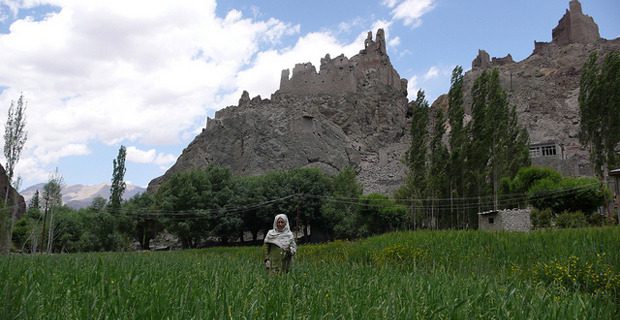
The History and Mystery of Ladakh’s Abandoned Kingdoms
Exploring the Ruins of Ladakh’s Past
Ladakh’s abandoned kingdoms are time capsules, their ruins a testament to a vibrant history lost to the ages. Once bustling outposts along the Silk Route, these settlements thrived as trade hubs connecting India, Tibet, and Central Asia. Today, their crumbling walls and deserted streets draw trekkers to “exploring the ruins of Ladakh’s past,” blending adventure with archaeology.
Take Hankar village in Markha Valley—its derelict fortress, perched on a hill, once guarded the valley from invaders. Stone foundations and faded inscriptions hint at a self-sufficient community, abandoned as trade routes shifted and climate harshened. Similarly, near Lamayuru, ancient mani walls and stupas dot the landscape, their weathered surfaces whispering tales of monks and merchants. “Discovering Ladakh’s hidden villages” captures this allure perfectly.
The mystery deepens with each site. Why were these kingdoms deserted? Harsh winters, dwindling resources, and isolation likely played roles, but oral histories add layers—tales of plagues or migrations linger in local lore. Trekkers often find pottery shards or prayer stones, artifacts that bring the past alive. This isn’t just a hike; it’s a journey through “Ladakh’s desolate kingdoms,” where every ruin holds a story.
The experience is visceral—standing amidst these relics, the wind carrying dust from centuries past, you feel part of something larger. For those searching “trekking Ladakh history,” these ruins offer a tangible link to a forgotten world, making every step a discovery of Ladakh’s enigmatic legacy.
The Spiritual Legacy of Ladakh’s Forgotten Monasteries
Ladakh’s forgotten monasteries are spiritual anchors in its abandoned kingdoms, their silence as powerful as their presence. These gompas, once centers of Buddhist learning, now stand deserted on cliffs and hillsides, their faded murals and broken idols evoking a lost era. Trekking to these sites—aligned with “treks to Ladakh’s hidden monasteries”—offers a profound connection to Ladakh’s soul.
Consider the abandoned outposts near Diskit in Nubra Valley. Once retreats for meditating monks, these small gompas cling to rocky outcrops, their interiors darkened by time. Prayer wheels, rusted and still, line the paths, while wind erodes ancient thangkas (religious paintings). “Spiritual echoes of Ladakh” resonate here, as the solitude amplifies their sacred past.
Historically, these monasteries supported surrounding villages, serving as schools, hospitals, and cultural hubs. Their decline mirrors the settlements’ fate—trade dried up, populations dwindled, and monks moved to larger, active gompas. Yet, their legacy endures in the architecture: domed roofs, intricate woodwork, and stupas that defy the elements. This ties into “Himalayan trekking routes,” where spirituality and adventure converge.
For trekkers, the experience is transcendent. Sitting in a deserted monastery, surrounded by towering peaks, you feel the weight of centuries. It’s a pilgrimage of sorts, blending physical effort with introspection. These forgotten sanctuaries make Ladakh’s trails more than a trek—they’re a journey into a spiritual past that refuses to fade.
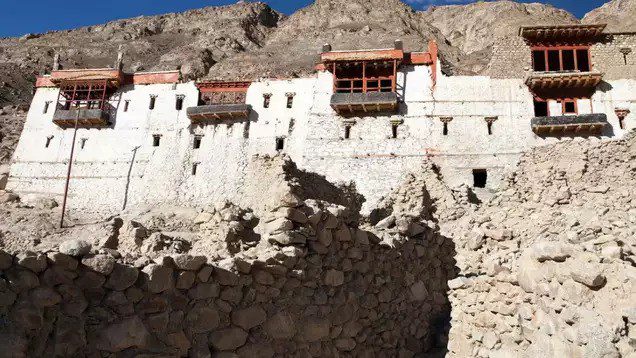
Essential Tips for Your Ladakh Trekking Adventure
Best Seasons for Trekking to Ladakh’s Kingdoms
Timing your trek to Ladakh’s abandoned kingdoms is critical—weather shapes the experience. The best seasons are summer (June to September) and early autumn (September to October), when trails are accessible and skies are clear. Summer offers warm days (15-25°C) and passable routes like Markha Valley, ideal for “best time for trekking in Ladakh mountains” seekers.
June to August brings lush valleys and flowing streams, though occasional rain can muddy lower trails. September to October cools down (5-20°C), painting the highlands in golden hues—perfect for photography and crisp hikes to forgotten settlements. Winter (November to May) closes high passes and buries ruins in snow, making most treks infeasible except for seasoned adventurers with specialized gear.
Each season has trade-offs. Summer’s warmth eases travel but draws more trekkers, while autumn’s solitude suits those chasing “Ladakh trails seasonal guide” vibes. Check local forecasts—sudden storms can disrupt plans—and align your itinerary with trail conditions. For Nubra Valley, summer’s dunes shimmer, while Lamayuru’s moonscape glows in autumn light.
Avoid monsoon peaks (July-August) in lower areas to dodge flash floods, and plan around festival dates (e.g., Hemis Festival) if you want quieter trails. This timing guide ensures you experience Ladakh’s rugged beauty and abandoned kingdoms at their finest, maximizing safety and awe.
Preparing Physically for Ladakh’s High-Altitude Trails
Trekking Ladakh’s high-altitude trails to abandoned kingdoms demands physical readiness—the thin air and steep climbs test even fit adventurers. Start training 2-3 months ahead, focusing on endurance and strength. Cardio is king: run, cycle, or hike 4-5 times weekly, building to 60-minute sessions. “Preparing for high-altitude treks in Ladakh” starts here.
Elevation is the challenge—trails often exceed 4,000 meters. Simulate altitude with hill climbs or stair workouts, carrying a 10-15 kg backpack to mimic trekking loads. Leg strength matters—squats, lunges, and calf raises prepare you for rocky ascents like Konzke La. Core exercises (planks, twists) stabilize you on uneven terrain.
Acclimatization can’t be shortcut. Arrive in Leh early, resting for 48 hours before trekking, and ascend gradually to avoid AMS. Hydrate obsessively—4-5 liters daily—and practice deep breathing to oxygenate your blood. “Ladakh trek preparation” includes diet: boost stamina with carbs (oats, rice) and iron-rich foods (spinach, lentils) weeks prior.
Test your gear on practice hikes—break in boots and check pack fit. Flexibility helps too—yoga or stretching eases muscle strain after long days. This regimen ensures you conquer Ladakh’s highlands, standing triumphant amidst its forgotten ruins, ready for the adventure of a lifetime.
Navigating Ladakh’s Untamed Landscapes
Navigating Ladakh’s untamed landscapes to its abandoned kingdoms requires skill and preparation—the vastness can disorient even seasoned trekkers. Start with reliable tools: a GPS device or offline maps (like Gaia GPS) are essential, as cell signals vanish in these highlands. “Navigating Ladakh trekking trails” hinges on staying oriented.
Learn landmarks—rock formations, river bends, or distant peaks guide you when trails fade. On Markha Valley, the Markha River is your lifeline; in Nubra, dunes and monastery silhouettes steer you. Trails aren’t always marked—carry a compass and study topo maps pre-trek. “Ladakh wilderness pathways” demand this vigilance.
Local knowledge helps—chat with villagers or hire a guide for tricky sections like Lamayuru’s passes. Time your days: start at dawn to avoid afternoon winds, and pace yourself (8-12 km daily) to reach campsites safely. Watch for cairns (stone piles)—trekkers’ breadcrumbs in this rugged terrain.
Weather dictates navigation—fog or snow can obscure paths, so check forecasts and pack a headlamp for emergencies. Practice route-finding on shorter hikes before tackling “trekking Ladakh off-the-grid.” Mastering these skills lets you explore Ladakh’s lost kingdoms with confidence, turning wilderness into wonder.
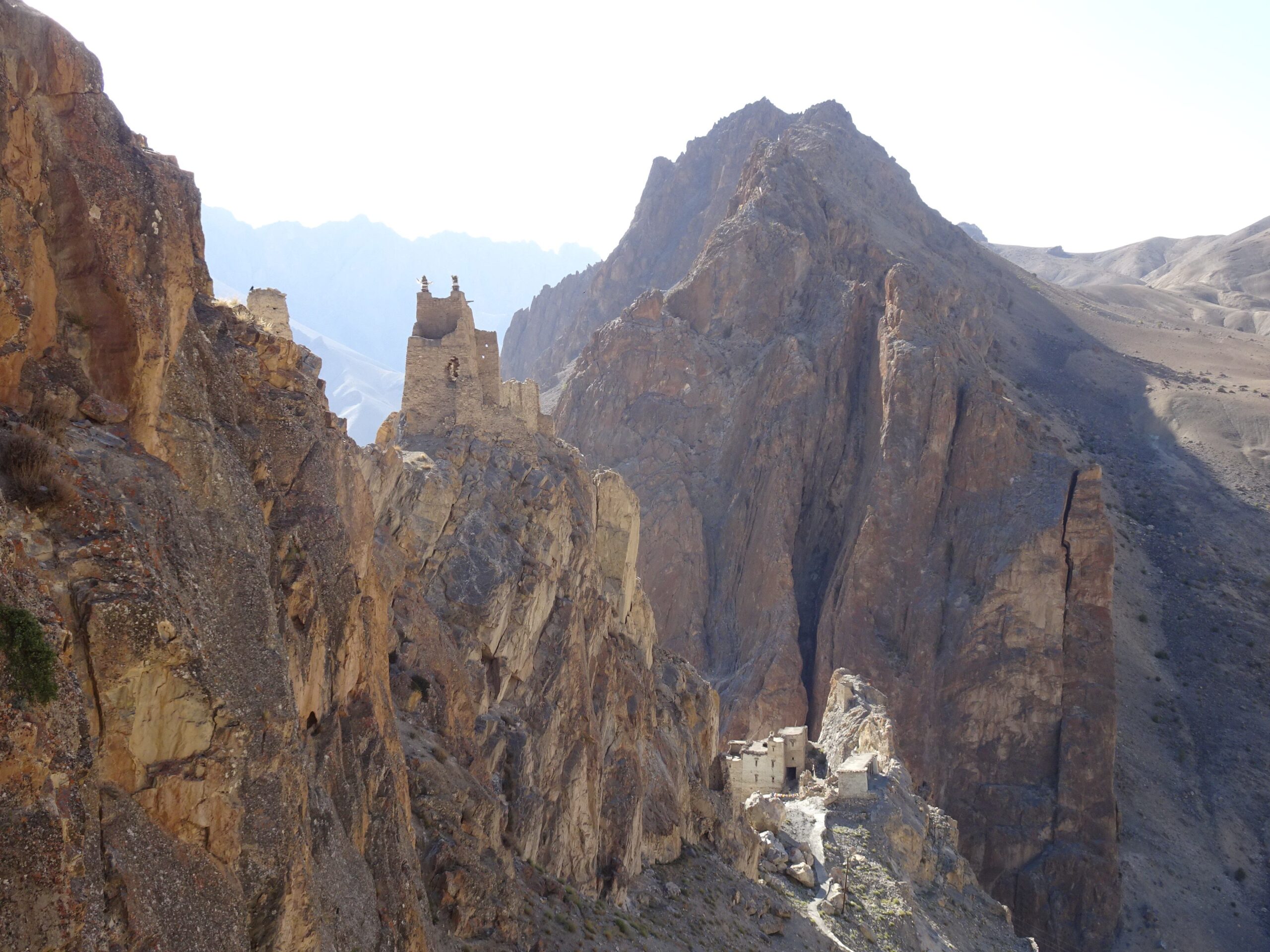
Conclusion: Step Into Ladakh’s Windswept Legacy
Ladakh’s abandoned mountain kingdoms await—rugged, remote, and rich with history. These treks blend physical challenge with the thrill of discovery, leading you to ruins and monasteries that whisper of a forgotten past. From Markha Valley’s hidden villages to Nubra’s desolate gompas, every trail offers a unique adventure, steeped in “Himalayan trekking adventures.” With the right gear, preparation, and timing, you’ll conquer these windswept landscapes, forging memories that last a lifetime.
Ready to embark? Plan your journey today, lace up your boots, and step into Ladakh’s timeless legacy—where every path leads to a story waiting to be uncovered.
FAQs
What’s the Best Trek for Beginners in Ladakh?
For beginners, the Markha Valley Trek stands out as the best introduction to Ladakh’s abandoned kingdoms. Spanning 6-8 days, it’s moderately challenging yet manageable with basic fitness. Starting near Leh, it offers gradual ascents, stunning views, and glimpses of forgotten villages like Hankar—all aligning with “Ladakh trails for beginners.” Acclimatize first, carry essentials (boots, layers), and enjoy a rewarding first trek.
How Safe Are Solo Treks in Ladakh?
Solo treks in Ladakh are safe with preparation—think acclimatization, navigation tools, and emergency gear. “Ladakh trek safety tips” emphasize gradual ascents and hydration to avoid AMS. Stick to known trails, share your itinerary, and carry a satellite phone. The isolation is serene, not dangerous, if you’re equipped for “solo travel Ladakh monasteries.”
What Permits Are Needed for Ladakh Treks?
Most treks to Ladakh’s abandoned kingdoms require an Inner Line Permit (ILP), available online or in Leh for $6-10. It covers restricted areas like Nubra Valley, valid for 7 days (extendable). No special trekking permits are needed for Markha or Lamayuru routes.
Ready to explore Ladakh’s forgotten kingdoms? Gear up, plan smart, and let these trails lead you to adventure!


